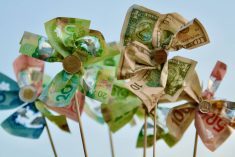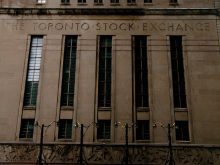In the early days of the Clinton administration, Democratic Party strategist James Carville opined that, after death, “I’d like to come back as the bond market. That way, I could intimidate everybody.” Bond prices determine bond yields and yields determine the weight of public debt — how fast taxes can pay it down, how affordable bridges and highways will be, and, for that matter, whether pension funds will thrive or die. Dull they may be, but bonds are the financial blood of public finance, pensions, and tax rates.
The 10-year U.S. Treasury bond, the world’s bellwether debt instrument, has recently been priced to yield 2.38 per cent, a little down from its recent peak yield of 2.62 per cent on March 13.
Read Also

Gentle treatments for pain in the neck
Heading toward year-end, people unknowingly tense up against the cold and busyness, causing neck pain that can often be treated with appropriate support and gentle mobility, athletic therapist Kathlyn Hossack says.
Bond yields are about risk and inflation. In the case of the U.S. 10 year T-bond, it’s also about risk, for U.S. inflation is a modest 2.3 per cent at annualized rates. For comparison’s sake, the 10-year Italian state bond carries a yield of 2.26 per cent and British 10-year sovereign bonds, called “gilts,” pay a modest 1.09 per cent with British inflation at 2.6 per cent. The U.S., it seems, is a bigger risk than Italy.
The stock market has been on a tear, up 12 per cent in U.S. dollar terms. Bond investors don’t believe it. The bond market is forecasting risk and trouble for the American economy while the stock market is aglow with rhapsodic investors who believe Trump will raise corporate profits. Who is right?
On average, stocks are priced at almost 30 times earnings, according to the Case Shiller Cyclically Adjusted Price Index (CAPE). This is the highest level since the tech bubble at its most optimistic in 2000. Professor Robert Shiller, a Nobel laureate who teaches at Yale, denies that this number implies a crash is at hand. Shiller suggests this means one should cut stock holdings and hold more cash and bonds. Put another way, when your stocks or any other asset is booming, take a little money off the table and diversify.
Stock market risks
A lot of risks could derail stocks. First, there is momentum. The S&P 500 index has not had a serious drop since Trump was elected. Second, there is President Trump’s wish for higher tariffs and trade barriers. This could reduce sales and profits for American companies. If the U.S. decides that American auto makers should not buy parts from China, higher costs of American-made parts for Fords and Jeeps would either raise sales prices, cut sales or reduce bottom line profits. Trump is bad for topline business even if he can deliver tax cuts on the bottom line.
Eventually, Trump’s policy of removing regulations to protect the environment will harm American output. Two recent executive orders from the White House — one, that coal mining companies need pay no penalty for dumping coal and waste into rivers and, two, that coal companies can mine on U.S. public lands, are symptoms of more regulatory rollbacks to come. Why does this matter? Because the un-priced or unpenaltied use of resources ultimately empties the cookie jar.
The Trump position that environmental regulations should be eliminated is going to be counterproductive. The Paris climate agreements are history from a U.S. point of view. China and India are big polluters but there is doubt that they will back the Paris accords if Washington does not. Visa restrictions for Mexicans may severely limit output in U.S. agriculture, especially in California’s fruit and nut belt. What drought has done in five years, Trump may equal in one, critics fear.
Some of this apprehension may be excessive. However, risks are rising. Trump proposes to reduce regulations that force banks to carry more capital to back their loans. That’s a return to the wacky lending standards that allowed NINJA loans (No Income, No Job, No Assets) to be liberally dispensed to people with no fixed address and no money. That was the malpractice underlying the mortgage meltdown in 2008 that nearly wrecked global finance. Could 2008 happen again? Not exactly, but pyramids of risk on bank balance sheets with highly leveraged capital are an invitation to another disaster.
Risks are rising in the U.S. stock market. Stocks magnify that risk. Investors tend to trade as a pack when they see stocks zooming up or tumbling down. On the up side, they bet on momentum continuing. When stocks are crumbling, there is a race to get out of the musical chairs. Stock markets that crash with 10 per cent drops in a series of days, or worse as in 2008 or 1987 when there were double digit falls during panic days, can do it again.
The alternative to stock risk
On top of high U.S. 10-year Treasury Bond interest, corporate investment grade bonds offer good returns and acceptable risk. For example, Canada’s insurance giant, Fairfax Financial Holdings Ltd., has a 4.95 per cent Canadian dollar issue with a BBB investment grade rating that yields 3.65 per cent per year to maturity on March 3, 2025. That is 2.19 per cent more than an eight-year Government of Canada bond, which pays 1.46 per cent per year to maturity and about the same yield as one could get from a public utility stock. To be sure, there are tax differences. In non-registered accounts, stocks dividends are puffed up for calculation purposes. That process increases taxable income and so can cause Old Age Security benefits to be reduced or lost.
Bond interest is not grossed up and thus does not have any magnified effect on OAS. An investor can cherry pick corporate bonds with investment grade ratings and, if Trump does no greater harm than the market expects, U.S. government and corporate bonds purchases will wind up diversifying your risks and provide a tidy return competitive with stocks dividends but with far more security.















